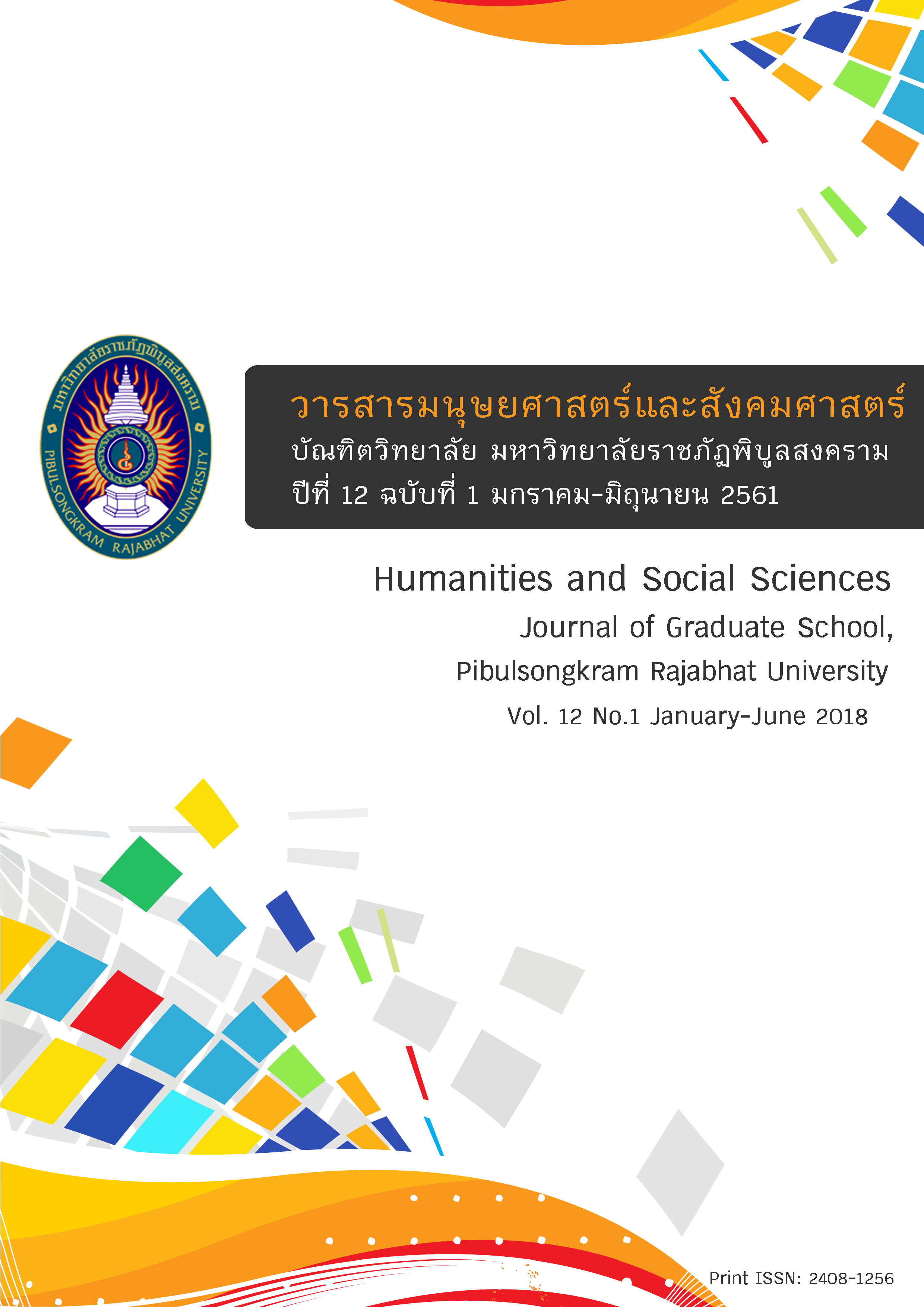An Analysis of the Main Characters in the Cartoon Version of Saiyu by Kai Ben
Keywords:
SAIYU, main characters, characteristic, status, roleAbstract
This research is aimed at studying the characteristics, statuses and roles of four main characters: Phra TangSamJang, Heng Jia, Tue Poi Kai and Sua Jung in the cartoon version of SAIYU by KAI BEN.
The study of the main characters shows that
- Phra TangSamJang is a human, male, who becomes a monk and dresses as a priest and always keeps his commandments. He is a kind, patient, weak and coward.
- Heng Jia is a magic monkey, with ordinary appearance as a monkey. He can become the other images when using magic. As for the ornaments, Heng wants to be like a human so he dresses like a human. After he has magic, he wears a pair of shoes made of lotus root, a golden armor, a golden crown, and a pair of velvet wings. Besides, he owns a golden cudgel. After becoming the follower of Phra Tang, he wears fur made of tiger skin and a golden hoop. He is brave, naughty, clever, impatient, roguish and confident.
- Tue Poi Kai is a pig monster with a pig head but human’s body. Hos weapon is a sharp rake. He’s lewd, greedy, lazy, and jealous.
- Sua Jung used to live under the water, and he is an ugly monster with long hair and red eyes. He has a necklace with nine skulls. Sua is grateful and understanding.
Study on the statuses and roles of the main characters shows that
- Phra Tang has original status and role when he was born, such as being a grandson who should help and take care of his grandmother, and a son who should be grateful to his parents. And the status and role after he was born, for example, as a monk, he is to spread religion and keeps monk's principle; as a leader seeking for scriptures, he is to educate his followers to be better.
- Heng’s original status and role were not like that when he was born, but he has status and role after he was born. As the leader of monkeys, he takes care and protects other monkeys. His job in heaven is to take care of the horses and pitch garden. As a Buddhist looking for scriptures, Heng has two statuses, such as being a disciple of Phra Tang who protects, helps, takes care and listens to Phra Tang; and being the leader of the disciples who takes care and protects the disciples.
- Tue has original status and role when he was born. As a child, he takes care of his mother, but he does not abide by the rule of his status and role. After being a Buddhist, Tue has two duties. One is being the disciple of Phra Tang who protects and takes care of Phra Tang; the second is being the disciple of Heng helping and listening to Heng.
- The original status and role of Sua when he was born: he is a water monster who does not follow his role and duty. The status and role of Sua after he was born: when being a Buddhist, Sua has two duties. As the disciple of Phra Tang whom he protects and takes care of; as the disciple of Heng whom he helps and listens to. Of the four main characters, only Phra Tang can comply with all of his duties. Heng Jia, Tue Poi Kai and Sua Jung comply with some of the duties.
The characters, statuses and roles of four main characters in the cartoon version of SAIYU by KAI BEN are not only to entertain readers but also to give them some ideas that can be used in life.
References
กุหลาบ มัลลิกะมาส. (2529). วรรณคดีวิจารณ์. กรุงเทพฯ: มหาวิทยาลัยรามคำแหง.
จิราภรณ์ ตั้งกิตติภาภรณ์. (2532). จิตวิทยาเบื้องต้น. สงขลา: มหาวิทยาลัยสงขลานครินทร์.
เซี่ยยู่ปิง. (1995). การศึกษาไซอิ๋วในประเทศไทย. ไทเป: มหาวิทยาลัยวัฒนธรรม.
. (2543). การแพร่เรื่องราว“เห้งเจีย”ของจีนและ “หนุมาน”ของอินเดียในประเทศไทย. ปักกิ่ง:มหาวิทยาลัยครูปักกิ่ง.
ถังหงเฟิน. (2552). วิเคราะห์ตัวละครซังเจ๋งในไซอิ๋ว (วิทยานิพนธ์ศิลปศาสตรมหาบัณฑิต). เหอเป่ย: วิทยาลัยบหันดัน.
ประเสริฐ แย้มกลิ่นฟุ้ง และคณะ. (2544). สังคมและวัฒนธรรม (พิมพ์ครั้งที่ 7). กรุงเทพฯ: สำนักพิมพ์จุฬาลงกรณ์มหาวิทยาลัย.
พัทยา สายหู. (2524). กลไกของสังคม. กรุงเทพฯ: โรงพิมพ์จุฬาลงกรณ์มหาวิทยาลัย.
พระมหาสนอง ปัจโจปการี. (2553). มนุษย์กับสังคม. กรุงเทพฯ: สำนักพิมพ์จุฬาลงกรณ์มหาวิทยาลัย.
ม.ล.บุญเหลือ เทพยสุวรรณ. (2518). แนะแนวทางการศึกษาวิชาวรรณคดี. กรุงเทพฯ: บัณฑิตการพิมพ์.
ส.พลายน้อย(นามแฝง). (2547). โหง่วเส็งอึง.(ไซอิ๋ว). นนทบุรี: สำนักพิมพ์ศรีปัญญา.
สายทิพย์ นุกูลกิจ. (2534). วรรณกรรมไทยปัจจุบัน. กรุงเทพฯ: มหาวิทยาลัยศรีนครินทรวิโรฒบางเชน.
สุชาดา สุธรรมรักษ์. (2531). เอกสารประกอบการสอนวิชา จต101 จิตวิทยาเบื้องต้น. กรุงเทพฯ: ภาควิชา แนะแนวและจิตวิทยาการศึกษา คณะศึกษาศาสตร์ มหาวิทยาลัยศรีนครินทรวิโรฒ, ปทุมวัน.
สุนันทา โสรัจจ์. (2526). บทวิเคราะห์-วิจารณ์พระเอกหรือผู้ร้ายในวรรณคดีไทย. กรุงเทพฯ: พิมพ์นิยมวิทยา.
สุพัตรา สุภาพ. (2532). สังคมและวัฒนธรรมไทย. กรุงเทพฯ: ไทยวัฒนาพานิช.
วราภรณ์ ตระกูลสฤษดิ์. (2544). "การศึกษาปัญหาและความต้องการของนักศึกษา มจธ.", การสัมมนาเรื่อง "การวิจัยทางการศึกษา ครั้งที่ 1, 18 กรกฎาคม.
หลี่ชิง. (2556). วิเคราะห์ตัวละครไซอิ๋ว (วิทยานิพนธ์การศึกษามหาบัณฑิต). ฉงชิ่ง: มหาวิทยาลัยภาคตะวันตกเฉียงใต้.
หยางหัว. (2554). วิเคราะห์ตัวละครตือโป๊ยก่ายในไซอิ๋ว (วิทยานิพนธ์ศิลปศาสตรมหาบัณฑิต). กวาวสี:มหาวิทยาลัยครูกวางสี.
อัจฉรา สุขารมณ์. (2524). จิตวิทยาในชีวิตประจำวัน. กรุงเทพฯ: สถาบันวิจัยพฤติกรรมศาสตร์ มหาวิทยาลัยศรีนครินทรวิโรฒ.
Downloads
Published
How to Cite
Issue
Section
License
Any articles or comments appearing in the Journal of Humanities and Social Sciences, Rajabhat Phibulsongkram University, are the intellectual property of the authors, and do not necessarily reflect the views of the editorial board. Published articles are copyrighted by the Journal of Humanities and Social Sciences, Rajabhat Phibulsongkram University.









